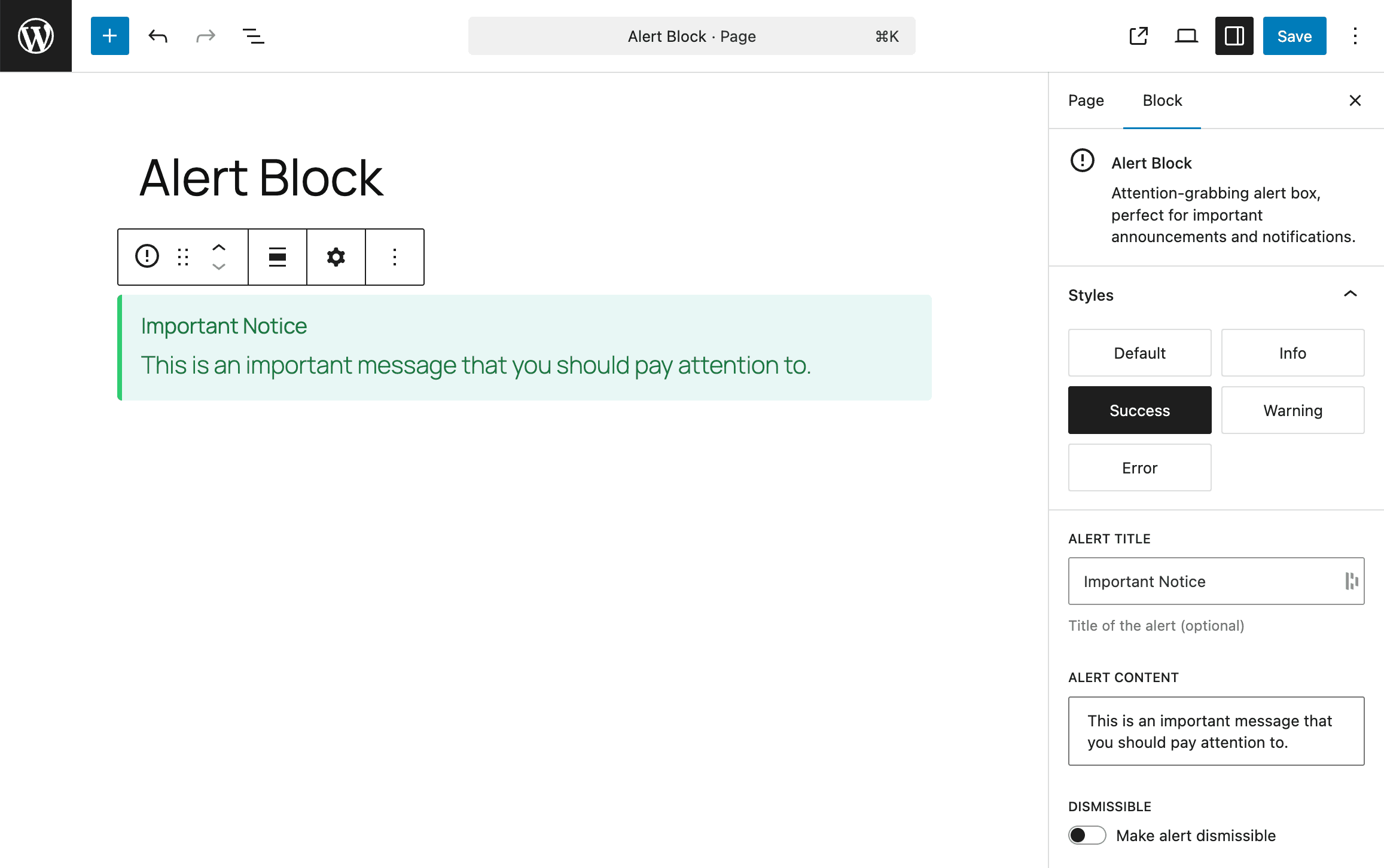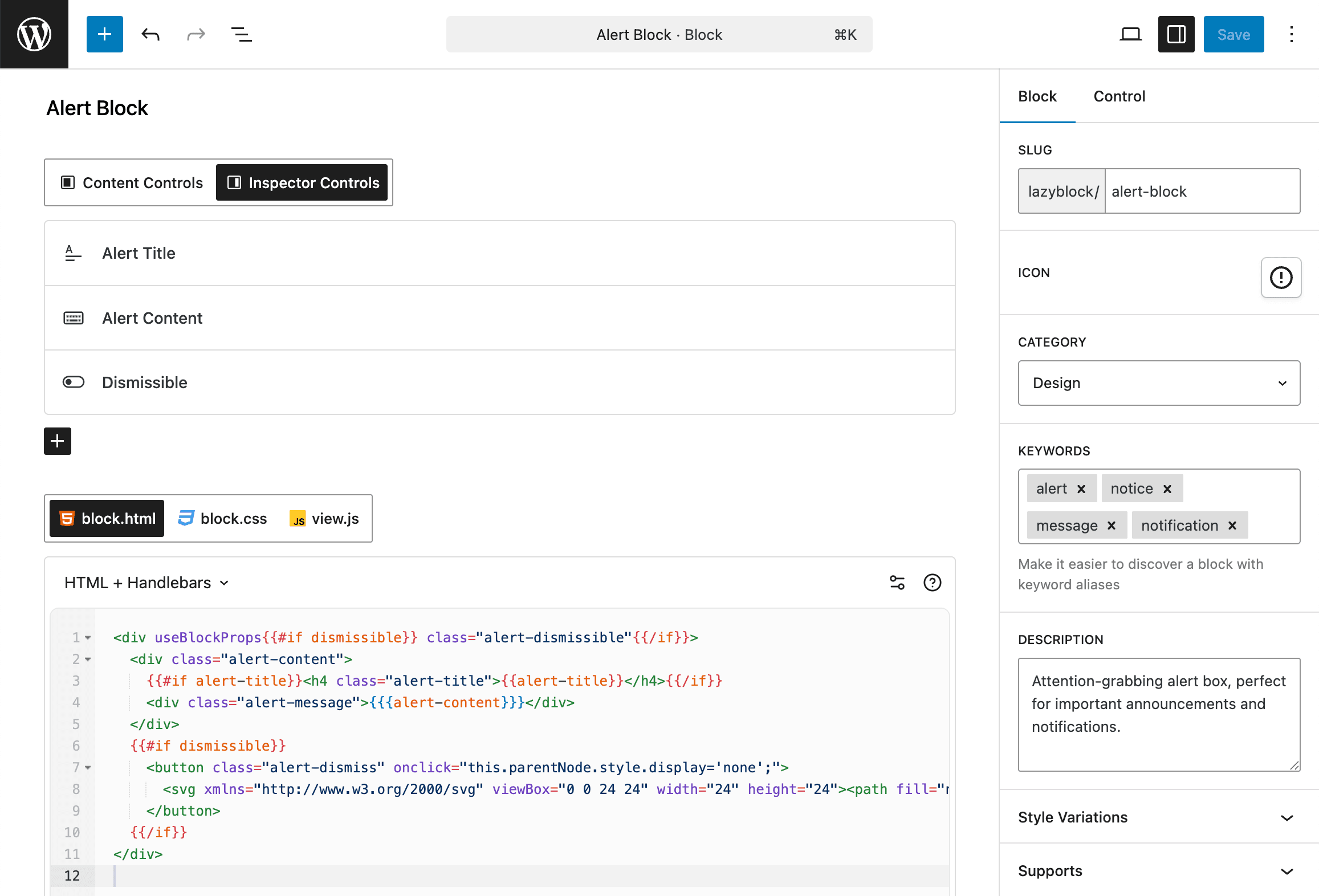Alert Block
This guide demonstrates how to create a custom Alert block using the Lazy Blocks plugin. The block supports multiple alert types, dismissible functionality, and custom content.

Creating the Alert Block
Step 1: Basic Block Configuration
Configure the essential block settings in the Lazy Blocks builder:
- Set block name, slug, and icon
- Choose appropriate category
- Add description and keywords for better discoverability
- Configure Style Variations for different alert types (Info, Success, Warning, Error)
Step 2: Adding Controls
Configure the following controls in the block builder:
-
Alert Title (Text control)
- Allows users to input an optional alert title
-
Alert Content (Rich Text control)
- Allows users to input the main alert message with rich text formatting
-
Dismissible (Toggle control)
- Enables/disables close button functionality

Step 3: Block Code
Add the template code in the Block Code section. This code will automatically work for both editor and frontend rendering. Choose either PHP or Handlebars template:
<div useBlockProps<?php echo $attributes['dismissible'] ? ' class="alert-dismissible"' : ''; ?>>
<div class="alert-content">
<?php if ( ! empty( $attributes['alert-title'] ) ) : ?>
<h4 class="alert-title"><?php echo esc_html( $attributes['alert-title'] ); ?></h4>
<?php endif; ?>
<div class="alert-message"><?php echo $attributes['alert-content']; ?></div>
</div>
<?php if ( $attributes['dismissible'] ) : ?>
<button class="alert-dismiss" onclick="this.parentNode.style.display='none';">
<svg xmlns="http://www.w3.org/2000/svg" viewBox="0 0 24 24" width="24" height="24">
<path fill="none" d="M0 0h24v24H0z"/>
<path d="M12 10.586l4.95-4.95 1.414 1.414-4.95 4.95 4.95 4.95-1.414 1.414-4.95-4.95-4.95 4.95-1.414-1.414 4.95-4.95-4.95-4.95L7.05 5.636z"/>
</svg>
</button>
<?php endif; ?>
</div><div useBlockProps{{#if dismissible}} class="alert-dismissible"{{/if}}>
<div class="alert-content">
{{#if alert-title}}<h4 class="alert-title">{{alert-title}}</h4>{{/if}}
<div class="alert-message">{{{alert-content}}}</div>
</div>
{{#if dismissible}}
<button class="alert-dismiss" onclick="this.parentNode.style.display='none';">
<svg xmlns="http://www.w3.org/2000/svg" viewBox="0 0 24 24" width="24" height="24">
<path fill="none" d="M0 0h24v24H0z"/>
<path d="M12 10.586l4.95-4.95 1.414 1.414-4.95 4.95 4.95 4.95-1.414 1.414-4.95-4.95-4.95 4.95-1.414-1.414 4.95-4.95-4.95-4.95L7.05 5.636z"/>
</svg>
</button>
{{/if}}
</div>Step 4: Block Styles
Add the CSS styles in the Block Styles section of the Lazy Blocks builder:
.wp-block-lazyblock-alert-block {
display: flex;
padding: 16px;
border-radius: 4px;
position: relative;
background-color: #f3f3f3;
border-left: 4px solid #b3b3b3;
color: #4a4a4a;
}
.wp-block-lazyblock-alert-block .alert-content {
flex-grow: 1;
}
.wp-block-lazyblock-alert-block .alert-title {
margin-top: 0;
margin-bottom: 8px;
font-size: 18px;
}
.wp-block-lazyblock-alert-block .alert-message p:last-child {
margin-bottom: 0;
}
.wp-block-lazyblock-alert-block .alert-dismiss {
background: none;
border: none;
cursor: pointer;
padding: 0;
position: absolute;
top: 16px;
right: 16px;
opacity: 0.7;
}
.wp-block-lazyblock-alert-block .alert-dismiss:hover {
opacity: 1;
}
/* Alert types */
.wp-block-lazyblock-alert-block.is-style-info {
background-color: #e8f4fd;
border-left: 4px solid #3498db;
color: #0c5d95;
}
.wp-block-lazyblock-alert-block.is-style-success {
background-color: #e8f8f5;
border-left: 4px solid #2ecc71;
color: #1b7943;
}
.wp-block-lazyblock-alert-block.is-style-warning {
background-color: #fef9e7;
border-left: 4px solid #f1c40f;
color: #9a7d0a;
}
.wp-block-lazyblock-alert-block.is-style-error {
background-color: #fdedec;
border-left: 4px solid #e74c3c;
color: #922b21;
}Style Variations
The Alert block comes with predefined Style Variations that can be applied in the WordPress editor. These are configured in the Basic Block Configuration step:
- Info - Blue styling for informational messages
- Success - Green styling for success messages
- Warning - Yellow styling for warning messages
- Error - Red styling for error messages
Theme Integration
Add this code to your theme's functions.php or plugin file:
add_action( 'lzb/init', function() {
lazyblocks()->add_block( array(
'title' => 'Alert Block',
'icon' => '<svg xmlns="http://www.w3.org/2000/svg" width="24" height="24" viewBox="0 0 24 24"><path d="M11 15h2v2h-2zm0-8h2v6h-2zm.99-5C6.47 2 2 6.48 2 12s4.47 10 9.99 10C17.52 22 22 17.52 22 12S17.52 2 11.99 2zM12 20c-4.42 0-8-3.58-8-8s3.58-8 8-8 8 3.58 8 8-3.58 8-8 8z"></path></svg>',
'keywords' => array(
'alert',
'notice',
'message',
'notification',
),
'slug' => 'lazyblock/alert-block',
'description' => 'Attention-grabbing alert box, perfect for important announcements and notifications.',
'category' => 'design',
'category_label' => 'design',
'supports' => array(
'customClassName' => true,
'anchor' => false,
'html' => false,
'multiple' => true,
'inserter' => true,
'reusable' => true,
'lock' => true,
'align' => array(
'wide',
'full',
),
),
'controls' => array(
'control_d4aad34f6e' => array(
'type' => 'text',
'name' => 'alert-title',
'default' => 'Important Notice',
'label' => 'Alert Title',
'help' => 'Title of the alert (optional)',
'placement' => 'inspector',
'translate' => 'true',
),
'control_3ebbb94850' => array(
'type' => 'rich_text',
'name' => 'alert-content',
'default' => 'This is an important message that you should pay attention to.',
'label' => 'Alert Content',
'placement' => 'inspector',
'translate' => 'true',
),
'control_daeade4589' => array(
'type' => 'toggle',
'name' => 'dismissible',
'default' => 'false',
'label' => 'Dismissible',
'placement' => 'inspector',
'checked' => 'false',
'alongside_text' => 'Make alert dismissible',
),
),
'code' => array(
'output_method' => 'html',
'editor_html' => '',
'editor_callback' => '',
'frontend_html' => '
/* INSERT BLOCK CODE HERE */
',
'frontend_callback' => '',
'show_preview' => 'always',
'single_output' => true,
),
'style' => array(
'block' => '
/* INSERT BLOCK STYLES HERE */
',
'editor' => '',
),
'script' => array(
'view' => '',
),
'styles' => array(
array(
'name' => 'info',
'label' => 'Info',
),
array(
'name' => 'success',
'label' => 'Success',
),
array(
'name' => 'warning',
'label' => 'Warning',
),
array(
'name' => 'error',
'label' => 'Error',
),
),
'condition' => array(),
) );
} );This implementation provides a fully functional Alert block that integrates seamlessly with the WordPress block editor with custom styling and multiple alert variations.